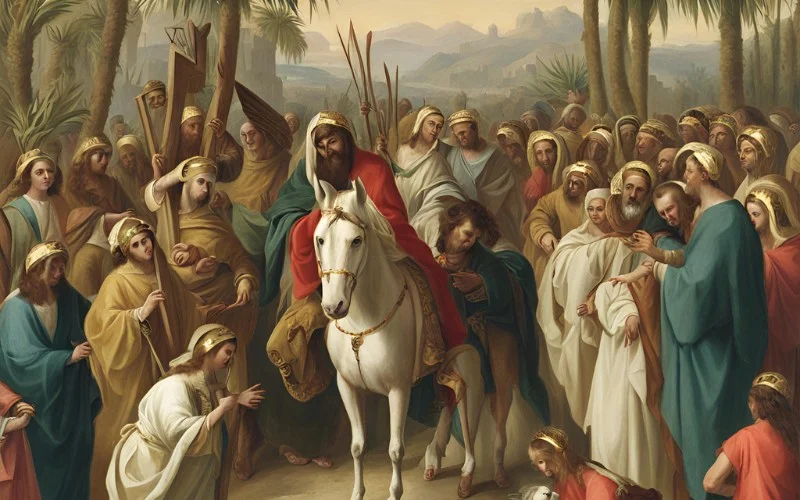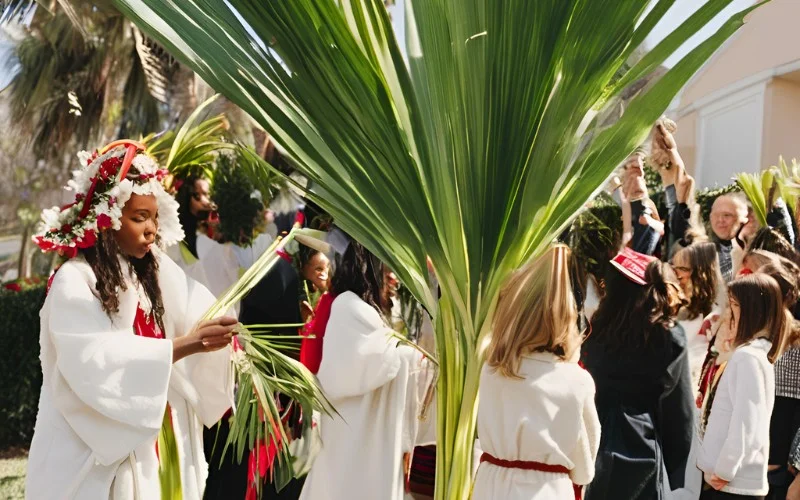As you explore the vibrant tapestry of Palm Sunday customs around the globe, you’ll find yourself intrigued by how different cultures celebrate this significant day in the Christian calendar.
Consider how a region’s historical backdrop, unique climate, and local folklore shape its observance. From the solemn processions in Spain to the colorful festivities in the Philippines, each variation reflects local traditions and embodies a deeper connection to communal and spiritual roots.
Why do these customs diverge so widely, and what might this tell us about the broader human experience of faith and culture?
Key Takeaways
- Cultural, religious, and regional traditions shape Palm Sunday customs, influenced by historical factors like colonization and migration.
- Local climate dictates the use of specific symbols and materials, such as palm branches, pussy willows, or artificial leaves.
- Differences in church liturgies and religious practices across denominations lead to varied celebrations and rituals.
- Folklore and legends integrate with religious observances, adding unique cultural elements to the festivities.
- Modern adaptations and interfaith exchanges introduce new practices and blend cultural elements, reflecting contemporary values and technologies.
Historical Influences on Traditions
Historical influences such as cultural practices, religious beliefs, and regional traditions have greatly shaped global Palm Sunday customs. You’ll find that events like colonization and migration have woven diverse cultural threads into the fabric of local celebrations.
In many countries, blending indigenous practices with Christian rituals during Palm Sunday has created unique observances that reflect a rich cultural mosaic.
For instance, in regions where European colonizers introduced Christianity, local traditions were often merged with the religious customs brought by the missionaries. This blending has resulted in Palm Sunday celebrations distinctly different from those in the colonizers’ home countries.
In Latin America, for example, native flowers and plants are used alongside or instead of the traditional palm branches, incorporating elements of native spirituality and symbolism.
Moreover, historical events such as religious reforms and interactions with other cultures have also played an important role. They’ve influenced not just the types of plants used but also how Palm Sunday is integrated into broader Holy Week observances.
This historical layering of customs shows how deeply Palm Sunday is intertwined with a community’s spiritual and cultural identity.
Religious Practices Across Cultures
Building on these historical layers, let’s explore how varying religious practices shape Palm Sunday customs across different cultures. You’ll find that Palm Sunday isn’t just a pivotal event marked similarly across the globe.
Instead, the diversity of religious beliefs and historical backgrounds greatly influences how this day is commemorated. In some cultures, Palm Sunday’s religious practices emphasize solemn processions, echoing the reverence seen in ancient texts.
In others, you might witness a more festive atmosphere, where the day also serves as a celebration of the coming spring. This variance largely depends on how local traditions and religious interpretations intertwine, showcasing the depth of cultural influences on this holy day.
Moreover, rituals unique to specific regions play an important role. For example, in one country, you might see the blessing of palm leaves, symbolizing Jesus’ triumphant entry into Jerusalem. In contrast, another culture might use olive branches, reflecting local flora and historical usage.
These practices aren’t random; they’re deeply rooted in how each community understands and values its spiritual heritage.
Symbolic Elements in Celebrations

Symbolic elements frequently vary across cultures during Palm Sunday celebrations, reflecting each community’s unique traditions and beliefs. Different regions incorporate symbols such as palm branches, crosses, flowers, and lanterns.
Each choice isn’t merely aesthetic; these symbols are steeped in the spiritual significance of Palm Sunday, embodying the solemn memories and joyful anticipations of the occasion.
In some cultures, palm branches aren’t just decorations; they are carried in processions to symbolize peace and victory, echoing Jesus’ triumphant entry into Jerusalem.
In others, flowers might signify new beginnings and hope, aligning with the spring season in which Palm Sunday occurs. Crosses, often made from palm fronds, are a poignant reminder of the sacrifices that define the holy week ahead.
The diversity of these symbols enriches the global tapestry of Palm Sunday observance. It vividly illustrates how cultural traditions shape communities’ spiritual landscapes.
You’re witnessing not just a religious event but a mosaic of deeply held beliefs and customs, each adding its unique color to Palm Sunday’s solemn yet celebratory atmosphere.
Impact of Local Climate
Local climate greatly influences Palm Sunday customs around the world. In countries where palm trees are scarce, traditions adapt to the surroundings. Take Poland, for instance, where artificial palm leaves are crafted for celebrations because real palm leaves aren’t available.
This adaptation shows how materials are chosen based on what’s accessible locally. In Latvia, the tradition morphs into Pussy Willow Sunday, reflecting the abundant pussy willows rather than palm fronds.
Here, the climate dictates the symbols and materials, integrating local flora into religious observances. Similarly, birch twigs replace the typical palm branches in Norway, where the landscape is lush with birch trees. This switch highlights local vegetation and ensures the continuation of Palm Sunday observances in a way that resonates with the natural environment.
Even in the Netherlands, where the climate mightn’t affect the availability of palms, local symbols like roosters associated with Easter are incorporated into the palm crosses.
This shows that climate influences the physical materials used and intertwines with cultural symbols to shape unique Palm Sunday traditions across different regions.
Role of Folklore and Legend

Moving beyond the impact of local climate, consider how folklore and legend profoundly shape Palm Sunday customs around the globe. You’ll find that these stories aren’t just tales from the past; they actively mold the various traditions you see today, contributing to the global diversity of this observance.
Folklore and legends are pivotal, turning each local celebration into a unique narrative tapestry. Here’s how these elements create vibrant and unique traditions:
- In some villages, children weave intricate palm crosses intertwined with local mythical figures, believed to bring protection and blessings.
- An old legend about a saint blessing the palms might lead a town to perform a dramatic reenactment during their procession.
- Folk tales often incorporate native flora into Palm Sunday rites, differing significantly from the standard palm branches.
- In certain cultures, folklore includes specific chants or songs believed to have been sung by angels; these are performed to guarantee a prosperous year.
- Some communities hold a night vigil before Palm Sunday, recounting ancient stories of heroes and saints who interacted with the holy week events.
These folklore-driven Palm Sunday customs enrich the cultural heritage and deepen the spiritual experience, showcasing a rich blend of history and faith across regions.
Church Liturgy Variations
Church liturgies on Palm Sunday vary considerably across Christian denominations, reflecting diverse theological emphases and cultural traditions.
Some denominations focus on Jesus’ triumphant entry into Jerusalem, with joyful hymns and vibrant readings recounting this moment.
In contrast, others might emphasize the somber foretelling of the events of Holy Week, incorporating more reflective prayers and hymns that prepare the congregation for Christ’s passion and resurrection.
The specific elements of the church liturgy, such as the colors used, the decorations adorning the church, and the rituals performed, also differ significantly. You might see various colors, from deep purples to bright reds, each symbolizing different aspects of the day’s significance.
Depending on the church’s liturgical tradition, the palm blessing, the procession around or within the church, and the distribution of palm crosses are carried out in various ways.
These liturgical differences highlight the distinct theological perspectives of each denomination and enrich the Palm Sunday observance’s overall tone and atmosphere. As you participate, you’re experiencing a unique interpretation and expression of a key event in the Christian faith.
Community Participation Differences
Community participation in Palm Sunday customs varies worldwide, reflecting a rich tapestry of cultural and religious expressions. Depending on where you are, you might see vastly different practices, each with unique traditions deeply rooted in the community’s history and faith.
- In Spain, you’d witness the grandeur of processions featuring a donkey, symbolizing Jesus’ humble entry into Jerusalem, surrounded by masses waving large palm branches.
- In Finland, imagine children dressed as Easter witches, wandering the streets and offering decorated willow twigs in exchange for treats, infusing a blend of Christian and local customs.
- In the Philippines, join devout crowds holding intricately woven palm fronds during Mass, a testimony to their deep religious fervor and craftsmanship.
- In Poland, you could participate in competitions where locals showcase giant fake palms, each aiming to outdo the others in creativity and size, fostering a sense of community pride and unity.
- In Haiti, be enveloped by the vibrant, colorful processions, where the community’s joy and solemnity are palpable, creating a mesmerizing spectacle of faith and culture.
These diverse ways of celebrating Palm Sunday highlight how deeply community participation is woven into the fabric of these unique traditions. Each custom, from palm branches to processions, tells a communal identity and spiritual significance story.
Influence of Colonial History
As we explore the varied customs of Palm Sunday, it’s important to contemplate how colonial history has influenced these traditions across different cultures. When you investigate the rich tapestry of Palm Sunday customs in other countries, you’ll see the deep marks left by colonial rule.
During their extensive periods of colonization, European powers didn’t just govern; they brought their religious customs and intertwined them with indigenous traditions.
For example, in some regions, Palm Sunday rituals incorporate local flora alongside traditional palm branches, a clear sign of blending practices.
This merging wasn’t merely coincidental but a result of colonialists introducing their religious observances, which mixed with local spiritual practices. Over the years, this fusion has created unique celebrations that reflect the indigenous cultures and the influences of European colonial history.
Understanding these influences isn’t just about tracing the origins of traditions but recognizing how colonial history has persistently shaped cultural expressions.
These customs aren’t static; they’re living testimonies to the complex interactions between colonizers and the indigenous populations. As you observe Palm Sunday, you’re witnessing a day shaped significantly by history’s reach across continents.
Adaptation to Modern Times

Palm Sunday celebrations have adapted to modern times, embracing technology with live streams and virtual gatherings that connect worshippers worldwide.
You can now participate in Palm Sunday from anywhere, not missing the solemnity and joy of this significant day. You’re virtually transported to the church through your screens, feeling the community spirit despite physical distances.
Technology isn’t just about views; it’s about interacting. You’re no longer a passive observer but an active participant. You can light virtual candles, share prayers online, and donate digitally to causes highlighted during the services.
Modern elements like social justice and environmental care are woven into sermons, making the ancient traditions resonate with today’s global concerns.
Imagine the scene:
- Families gathered around their living room, laptops open, as palms are blessed through their screens.
- Digital screens in homes flashing vibrant images of Jerusalem to deepen the virtual experience.
- Youth engage in discussions via post-sermon online forums, connecting faith across continents.
- Virtual choirs harmonize hymns, their voices streaming from speakers in various corners of the world.
- Attendees sharing eco-friendly craft ideas for homemade palms on social media platforms.
This fusion of Palm Sunday, virtual celebrations, and modern technology exemplifies how deeply traditions can evolve while staying true to their roots.
Interfaith Exchanges and Influences
Interfaith exchanges enrich Palm Sunday celebrations worldwide, blending diverse religious practices and cultural traditions. These exchanges greatly influence how cultures observe this day, marking the beginning of Holy Week with unique local flavors.
For example, the vibrant Palm Sunday festivities in Haiti showcase a compelling fusion of Catholic and Voodoo traditions. This blend colors the ceremonies and deepens their religious significance, demonstrating how cultural influences reshape traditional spiritual practices.
In Ethiopia, the celebration known as Hosanna reflects a distinct combination of cultural and religious elements unique to the Ethiopian Orthodox Christian community. This interfaith dialogue enriches the observance, making it both spiritual and artistic.
Meanwhile, in Mexico, indigenous techniques in palm weaving aren’t merely artistic expressions but also a reiteration of religious beliefs, tying local customs closely with the sacred narrative of Palm Sunday.
Moreover, Spain’s Procession of the Donkey integrates local customs into the religious observance, symbolizing Jesus’ entry into Jerusalem in a manner that resonates deeply with Spanish cultural identity. These examples illustrate how global Palm Sunday customs vary, underpinned by a tapestry of interfaith exchanges and cultural influences that celebrate diversity and faith.
Conclusion
As you’ve seen, Palm Sunday customs vary globally due to historical, religious, and cultural factors. Whether it’s the impact of local climate, the nuances of colonial history, or the adaptations to modern times, these elements shape unique celebrations.
By understanding these differences, you can appreciate the rich diversity of Palm Sunday observances worldwide. This blend of traditions enriches the holiday and bridges communities through shared yet distinct spiritual expressions.
Explore More Articles:
Bloom Where You Are Planted: Thriving in Any Environment
Ezekiel Biblical Angels: Exploring Celestial Beings in Scripture
10 Best Symbols of Palms in Christian Worship



